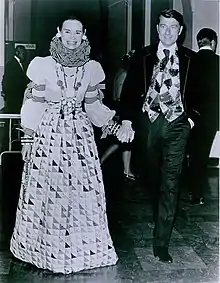Adolfo (designer)
Adolfo Sardiña (born 15 February 1933), professionally known as Adolfo, is a Cuban-born American fashion designer who started out as a milliner in the 1950s. While chief designer for the wholesale milliners Emme, he won the Coty Award and the Neiman Marcus Fashion Award. In 1963 he set up his own salon in New York, firstly as a milliner, and then focusing on clothing. He retired from fashion design in 1993.
Early life
Adolfo Sardiña was born in Cárdenas, Cuba on 15 February 1933.[1][2] His mother was Irish; his father Spanish.[3] He attended the St Ignacio de Loyola Jesuit School in Havana and served in the Cuban Army.[1] In 1948 Adolfo immigrated to New York.[2]
Millinery
As his mother had died in childbirth, Adolfo was brought up by an aunt who enjoyed wearing French haute couture, and encouraged her nephew to pursue fashion design.[2] With his aunt's help, Adolfo joined Cristóbal Balenciaga as an apprentice milliner.[2] He worked at Balenciaga from 1950–52.[1]
In 1953 Adolfo joined the New York-based wholesale millinery company Emme as their chief designer.[2] In the summer of 1957, to further his skills, he served an unpaid apprenticeship with Coco Chanel's New York hat salon.[1][2] Adolfo would later admit that he "never enjoyed making hats."[4]
Adolfo won a Coty Award in 1955 for millinery.[5] In 1959, Emme were awarded the Neiman Marcus Fashion Award.[6]
Fashion

With financial help from Bill Blass,[8] Adolfo opened his first salon in New York in 1963, where he met many of the customers who would become his patrons when he gave up millinery to focus on clothing. He had met the Duchess of Windsor by 1965, through whom he met regular customers Betsy Bloomingdale, Babe Paley and Nancy Reagan.[4] After Mainbocher retired, one of his highest-profile clients, C. Z. Guest, came to Adolfo to make her clothes instead.[4] Adolfo's clothes were designed to complement his hats, which the designer saw as an optional accessory rather than a wardrobe essential.[9]
At first Adolfo's extravagant, elaborately ornamental clothing seemed at odds with the relaxed principles behind American sportswear.[9] He created individually beautiful garments designed to be worn together or separately, commenting in 1968 that "one has to dress in bits and pieces — the more the merrier."[9] His 1960s "fun and fantasy" looks included richly embellished bolero jackets, organdy blouses, and evening ensembles made from antique patchwork quilts which were worn by the likes of Gloria Vanderbilt.[9] In 1969 Adolfo won another Coty Award.[5] That year, he claimed that classic clothing no longer appealed to the consumer, but soon afterwards, drastically changed his design approach to offer quietly understated clothing such as fur-trimmed knitwear, pyjama suits and ballgown skirts paired with sweaters.[9] He started selling knitted dresses to the department stores Saks Fifth Avenue and Neiman Marcus.[4]
In the summer of 1966 Adolfo had returned to Chanel to serve another unpaid apprenticeship,[1] and would openly acknowledge her influence on his work.[4] Adolfo's "Chanel jackets" and knit daywear became best-selling designs from the early 1970s onwards, and a design signature throughout his career.[4][10] In 1978 he launched Adolfo Menswear Inc. and Adolfo Scarves Inc, and in 1979, a perfume line.[1]
Adolfo became a member of the Council of Fashion Designers of America in 1982.[1]
In 1993, at the age of 60, Adolfo decided to retire from fashion design and rely on the income from his licensing agreements with various manufacturers.[4] Licensed Adolfo merchandise, including menswear, hats and accessories, luggage, sportswear, furs and perfume, was retailed widely at all consumer levels from Bloomingdale's through to J. C. Penney and the television shopping network QVC.[4] In 1993, Adolfo's licensing agreements for perfume sales alone had a wholesale return of over 5 million dollars.[4] By 2014, Adolfo was once again designing for his ready-to-wear clothing lines.[11]
Personal life
Adolfo's partner, Edward C. Perry, died in 1993.[12]
References
- Sleeman, Elizabeth, ed. (2003). The international who's who 2004 (67th ed.). London: Europa. p. 414. ISBN 9781857432176.
- Staff writer. "Adolfo (part 1)". NMAH: Hispanic Designers. National Museum of American History. Retrieved 14 October 2015.
- Alberg Grossman, Karen (2009). "Charm and Talent: Were there only more fashion designers like Adolfo!". MR Magazine. Retrieved 14 October 2015.
- Schiro, Anne-Marie (19 March 1993). "Adolfo Decides To Quit Designing". The New York Times. Retrieved 14 October 2015.
- McDowell, Colin (1984). McDowell's Directory of Twentieth Century Fashion. Frederick Muller. pp. 299–301. ISBN 0-584-11070-7.
- Staff writer (25 October 2002). "The Neiman's Seal of Approval". Women's Wear Daily. via Highbeam (subscription required). Archived from the original on 2 April 2015. Retrieved 2 March 2015.
- "Evening ensemble by Adolfo". V&A Search the Collections. 28 May 2019. Retrieved 27 May 2019.
- Staff writer. "Adolfo (part 2)". NMAH: Hispanic Designers. National Museum of American History. Retrieved 14 October 2015.
- Milford-Cottam, Daniel. "Evening ensemble by Adolfo, 1967". Search the Collections. Victoria and Albert Museum. Retrieved 14 October 2015.
- Staff writer. "Adolfo (part 4)". NMAH: Hispanic Designers. National Museum of American History. Retrieved 14 October 2015.
- Parker, Lauren (20 January 2014). "Designer Profile Master Class: Adolfo taps into his couture roots to offer affordable fashion". Accessories Magazine. Retrieved 14 October 2015.
- Staff writer (23 October 1993). "Edward C. Perry; Financial Adviser, 84". The New York Times. Retrieved 14 October 2015.